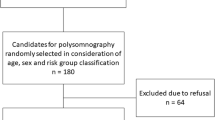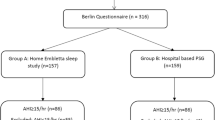Abstract
Introduction
Obstructive sleep apnea (OSA) affects up to 30% of the adult population and is a risk factor for coronary artery disease (CAD). The diagnostic process, involving polysomnography, may be complex. Berlin questionnaire (BQ) is a validated and economical screening tool.
Purpose
The aim of this study was to assess the performance of the BQ for the diagnosis of OSA in individuals with angina complaints.
Methods
Patients undergoing diagnostic cineangiography, portable type III polysomnography to determine the apnea-hypopnea index (AHI), and who answered the BQ were included. We excluded patients older than 65 years that were smokers, diabetics, and morbidly obese. High risk for OSA was based on positive responses in two of three symptom criteria of the BQ. CAD was defined by the presence of >50% lesion in coronary arteries.
Results
In 57 included cases, high risk in the BQ indicates significant odds ratio [95% confidence interval] for the presence of CAD (4.5[1.03–19.25], P = 0.045), adjusted for usual confounders: gender, age, and body mass index. The sensitivity and the specificity of BQ for CAD were 70% and 48%, respectively; the positive and negative predictive values are 56% and 64%.
Conclusions
In conclusion, simple questionnaire-based diagnostic tools can be included in the screening procedures of patients with angina to detect the need for further OSA evaluation. In conclusion, the BQ is an effective instrument for this purpose.

Similar content being viewed by others
References
Young T, Peppard PE, Gottlieb DJ (2002) Epidemiology of obstructive sleep apnea: a population health perspective. Am J Respir Crit Care Med 165:1217–1239. doi:10.1164/rccm.2109080
Lee W, Nagubadi S, Kryger MH, Mokhlesi B (2008) Epidemiology of obstructive sleep apnea: a population-based perspective. Expert Rev Respir Med 2:349–364
Tufik S, Santos-Silva R, Taddei JA, Bittencourt LR (2010) Obstructive sleep apnea syndrome in the Sao Paulo Epidemiologic Sleep Study. Sleep Med 11:441–446
Drager LF, Bortolotto LA, Lorenzi MC, Figueiredo AC, Krieger EM, Lorenzi-Filho G (2005) Early signs of atherosclerosis in obstructive sleep apnea. Am J Respir Crit Care Med 172:613–618. doi:10.1164/rccm.200503-340OC
Kim SH, Cho GY, Baik I, Kim J, Kim SJ, Lee JB, Lim HE, Lim SY, Park J, Shin C (2009) Association of coronary artery calcification with obstructive sleep apnea and obesity in middle-aged men. Nutr Metab Cardiovasc Dis 20:575–582. doi:10.1016/j.numecd.2009.05.011
Butt M, Dwivedi G, Khair O, Lip GY (2009) Obstructive sleep apnea and cardiovascular disease. Int J Cardiol 139:7–16. doi:10.1016/j.ijcard.2009.05.021
Bradley TD, Floras JS (2009) Obstructive sleep apnoea and its cardiovascular consequences. Lancet 373:82–93. doi:10.1016/S0140-6736(08)61622-0
Somers VK, White DP, Amin R, Abraham WT, Costa F, Culebras A, Daniels S, Floras JS, Hunt CE, Olson LJ, Pickering TG, Russell R, Woo M, Young T (2008) Sleep apnea and cardiovascular disease: an American Heart Association/american College of Cardiology Foundation Scientific Statement from the American Heart Association Council for High Blood Pressure Research Professional Education Committee, Council on Clinical Cardiology, Stroke Council, and Council on Cardiovascular Nursing. In collaboration with the National Heart, Lung, and Blood Institute National Center on Sleep Disorders Research (National Institutes of Health). Circulation 118:1080–1111
Hayashi M, Fujimoto K, Urushibata K, Uchikawa S, Imamura H, Kubo K (2003) Nocturnal oxygen desaturation correlates with the severity of coronary atherosclerosis in coronary artery disease. Chest 124:936–941
Peker Y, Carlson J, Hedner J (2006) Increased incidence of coronary artery disease in sleep apnoea: a long-term follow-up. Eur Respir J 28:596–602. doi:10.1183/09031936.06.00107805
Tasali E, Mokhlesi B, Van Cauter E (2008) Obstructive sleep apnea and type 2 diabetes: interacting epidemics. Chest 133:496–506. doi:10.1378/chest.07-0828
Reichmuth KJ, Austin D, Skatrud JB, Young T (2005) Association of sleep apnea and type II diabetes: a population-based study. Am J Respir Crit Care Med 172:1590–1595. doi:10.1164/rccm.200504-637OC
Phillipson EA (1993) Sleep apnea-a major public health problem. N Engl J Med 328:1271–1273
Yaggi HK, Concato J, Kernan WN, Lichtman JH, Brass LM, Mohsenin V (2005) Obstructive sleep apnea as a risk factor for stroke and death. N Engl J Med 353:2034–2041
Marin JM, Carrizo SJ, Vicente E, Agusti AG (2005) Long-term cardiovascular outcomes in men with obstructive sleep apnoea-hypopnoea with or without treatment with continuous positive airway pressure: an observational study. Lancet 365:1046–1053. doi:10.1016/S0140-6736(05)71141-7
Shah NA, Yaggi HK, Concato J, Mohsenin V (2010) Obstructive sleep apnea as a risk factor for coronary events or cardiovascular death. Sleep Breat 14:131–136. doi:10.1007/s11325-009-0298-7
Young T, Finn L, Peppard PE, Szklo-Coxe M, Austin D, Nieto FJ, Stubbs R, Hla KM (2008) Sleep disordered breathing and mortality: eighteen-year follow-up of the Wisconsin sleep cohort. Sleep 31:1071–1078
Punjabi NM, Caffo BS, Goodwin JL, Gottlieb DJ, Newman AB, O’Connor GT, Rapoport DM, Redline S, Resnick HE, Robbins JA, Shahar E, Unruh ML, Samet JM (2009) Sleep-disordered breathing and mortality: a prospective cohort study. PLoS Med. doi:10.1371/journal.pmed.1000132
Selim B, Won C, Yaggi HK (2010) Cardiovascular consequences of sleep apnea. Clin Chest Med 31:203–220. doi:10.1016/j.ccm.2010.02.010
Attal P, Chanson P (2010) Endocrine aspects of obstructive sleep apnea. J Clin Endocrinol Metab 95:483–495. doi:10.1210/jc.2009-1912
Gami AS, Hodge DO, Herges RM, Olson EJ, Nykodym J, Kara T, Somers VK (2007) Obstructive sleep apnea, obesity, and the risk of incident atrial fibrillation. J Am Coll Cardiol 49:565–571. doi:10.1016/j.jacc.2006.08.060
Eikermann M, Jordan AS, Chamberlin NL, Gautam S, Wellman A, Lo YL, White DP, Malhotra A (2007) The influence of aging on pharyngeal collapsibility during sleep. Chest 131:1702–1709. doi:10.1378/chest.06-2653
Knorst MM, Souza FJ, Martinez D (2008) Obstructive sleep apnea-hypopnea syndrome:association with gender, obesity and sleepiness-related factors. J Bras Pneumol 34:490–496. doi:10.1590/S1806-37132008000700009
Ye L, Pien GW, Weaver TE (2000) Gender differences in the clinical manifestation of obstructive sleep apnea. Sleep Med 9(10):1075–1084
Libby P, Theroux P (2005) Pathophysiology of coronary artery disease. Circulation 111:3481–3488. doi:10.1161/CIRCULATIONAHA.105.537878
Dempsey JA, Veasey SC, Morgan BJ, O’Donnell CP (2010) Pathophysiology of sleep apnea. Physiol Rev 90:47–112
Graille V, Ferrières J, Evans A, Amouyel P, Arveiler D, Luc G, Ducimetière P (2000) Associations between classical cardiovascular risk factors and coronary artery disease in two countries at contrasting risk for myocardial infarction: the PRIME study. Int J Cardiol 74:191–198. doi:10.1016/S0167-5273(00)00283-7
Yumino D, Tsurumi Y, Takagi A, Suzuki K, Kasanuki H (2007) Impact of obstructive sleep apnea on clinical and angiographic outcomes following percutaneous coronary intervention in patients with acute coronary syndrome. Am J Cardiol 99:26–30. doi:10.1016/j.amjcard.2006.07.055|
Lorenzi-Filho G, Drager LF (2007) Obstructive sleep apnea and atherosclerosis: a new paradigm. Am J Respir Crit Care Med 175:1219–1221. doi:10.1164/rccm.200703-458ED
Southwell C, Moallem M, Auckley D (2008) Cardiologist’s knowledge and attitudes about obstructive sleep apnea: a survey study. Sleep Breath 12:295–302. doi:10.1007/s11325-008-0170-1
Cassar A, Morgenthaler TI, Lennon RJ, Rihal CS, Lerman A (2007) Treatment of obstructive sleep apnea is associated with decreased cardiac death after percutaneous coronary intervention. J Am Coll Cardiol 50:1310–1314. doi:10.1016/j.jacc.2007.06.028
Buchner NJ, Sanner BM, Borgel J, Rump LC (2007) Continuous positive airway pressure treatment of mild to moderate obstructive sleep apnea reduces cardiovascular risk. Am J Respir Crit Care Med 176:1274–1280. doi:10.1164/rccm.200611-1588OC
Martínez-García MA, Soler-Cataluña JJ, Ejarque-Martínez L, Soriano Y, Román-Sánchez P, Illa FB, Canal JM, Durán-Cantolla J (2009) Continuous positive airway pressure treatment reduces mortality in patients with ischemic stroke and obstructive sleep apnea: a 5-year follow-up study. Am J Respir Crit Care Med 180:36–41. doi:10.1164/rccm.200611-1588OC
Chung S, Yoon IY, Lee CH, Kim JW (2010) The effects of nasal continuous positive airway pressure on vascular functions and serum cardiovascular risk factors in obstructive sleep apnea syndrome. Sleep Breath. doi:10.1007/s11325-009-0323-x
Kushida CA, Littner MR, Morgenthaler T, Alessi CA, Bailey D, Coleman J Jr, Friedman L, Hirshkowitz M, Kapen S, Kramer M, Lee-Chiong T, Loube DL, Owens J, Pancer JP, Wise M (2005) Practice parameters for the indications for polysomnography and related procedures: an update for 2005. Sleep 28:499–521
Collop NA, Anderson WM, Boehlecke B, Claman D, Goldberg R, Gottlieb DJ, Hudgel D, Sateia M, Schwab R (2007) Clinical guidelines for the use of unattended portable monitors in the diagnosis of obstructive sleep apnea in adult patients. Portable Monitoring Task Force of the American Academy of Sleep Medicine. J Clin Sleep Med 15(3):737–747
Tonelli de Oliveira AC, Martinez D, Vasconcelos LF, Gonçalves SC, Lenz MC, Fuchs SC, Gus M, Abreu-Silva EO, Moreira LB, Fuchs FD (2009) Diagnosis of obstructive sleep apnea syndrome and its outcomes with home portable monitoring. Chest 135:330–336. doi:10.1378/chest.08-1859
Lee-Chiong L (2010) Best of sleep medicine 2010. An annual collection of scientific literature.
Ayas NT, Fox J, Epstein L, Ryan CF, Fleetham JA (2010) Initial use of portable monitoring versus polysomnography to confirm obstructive sleep apnea in symptomatic patients: an economic decision model. Sleep Med 11:320–324
Netzer NC, Stoohs RA, Netzer CM, Clark K, Strohl KP (1999) Using the Berlin Questionnaire to identify patients at risk for the sleep apnea syndrome. Ann Intern Med 131:485–491
Ong TH, Raudha S, Fook-Chong S, Lew N, Hsu AA (2010) Simplifying STOP-BANG: use of a simple questionnaire to screen for OSA in an Asian population. Sleep Breath. doi:10.1007/s11325-010-0350-7
Gus M, Gonçalves SC, Martinez D, de Abreu Silva EO, Moreira LB, Fuchs SC, Fuchs FD (2008) Risk for Obstructive Sleep Apnea by Berlin Questionnaire, but not daytime sleepiness, is associated with resistant hypertension: a case-control study. Am J Hypertens 21:832–835. doi:10.1038/ajh.2008.184
Chung F, Yegneswaran B, Liao P, Chung SA, Vairavanathan S, Islam S, Khajehdehi A, Shapiro CM (2008) Validation of the Berlin questionnaire and American Society of Anesthesiologists checklist as screening tools for obstructive sleep apnea in surgical patients. Anesthesiology 108:822–830. doi:10.1097/ALN.0b013e31816d91b5
Klein C, Martinez D, Hackenhaar FS, Medeiros TM, Marcolin ML, Silveira FS, Wainstein MV, Gonçalvez SC, Benfato MS (2010) Carbonyl groups: bridging the gap between sleep disordered breathing and coronary artery disease. Free Radic Res 44:907–912
American Academy of Sleep Medicine Task Force (1999) Sleep-related breathing disorders in adults: recommendations for syndrome definition and measurement techniques in clinical research. Sleep 22:667–689
The International Classification of Sleep Disorders, 2nd edition, Diagnostic and Coding Manual. Hauri, PJ, (Ed),Westchester, American Academy of Sleep Medicine, 2005
Flemons WW (2002) Clinical practice. Obstructive sleep apnea. N Engl J Med 347:498–504
Pang KP, Terris DJ (2006) Screening for obstructive sleep apnea: an evidence-based analysis. Am J Otolaryngol 27:112–118. doi:10.1016/j.amjoto.2005.09.002
Chilukuri K, Dalal D, Marine JE, Scherr D, Henrikson CA, Cheng A, Nazarian S, Spragg D, Berger R, Calkins H (2009) Predictive value of obstructive sleep apnoea assessed by the Berlin Questionnaire for outcomes after the catheter ablation of atrial fibrillation. Europace 11:896–901. doi:10.1093/europace/eup064
Hiestand DM, Britz P, Goldman M, Phillips B (2006) Prevalence of symptoms and risk of sleep apnea in the US population: results from the national sleep foundation sleep in America 2005 poll. Chest 130:780–786. doi:10.1378/chest.130.3.780
Acknowledgments
The authors would like to thank Drs. Marco Vugman Wainstein and Jorge Pinto Ribeiro for their valuable contribution in providing data from the cineangiocoronariography.
Conflict of interest
None.
Financial support
Financial support was granted by the Brazilian Government (CAPES e CNPq grants) through a research incentive fund (FIPE) of the Hospital de Clínicas de Porto Alegre.
Author information
Authors and Affiliations
Corresponding author
Rights and permissions
About this article
Cite this article
Martinez, D., da Silva, R.P., Klein, C. et al. High risk for sleep apnea in the Berlin questionnaire and coronary artery disease. Sleep Breath 16, 89–94 (2012). https://doi.org/10.1007/s11325-010-0460-2
Received:
Revised:
Accepted:
Published:
Issue Date:
DOI: https://doi.org/10.1007/s11325-010-0460-2




